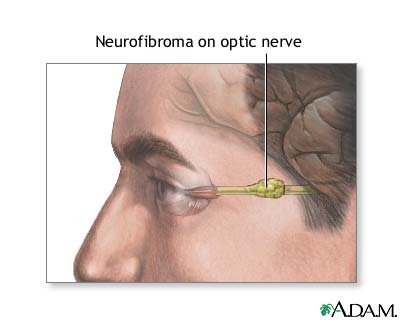Treatment
There is no specific treatment for neurofibromatosis. Tumors that cause pain or loss of function may be removed. Tumors that have grown quickly should be removed promptly as they may become cancerous (malignant). Experimental treatments for severe tumors are under investigation.
Some children with learning disorders may need special schooling.
Support Groups
For more information and resources, contact the National Neurofibromatosis Foundation.
Prognosis (Expectations)
If there are no complications, the life expectancy of people with neurofibromatosis is almost normal. With the right education and job expectations, people with neurofibromatosis can live a normal life.
Although mental impairment is generally mild, NF1 is a known cause of attention deficit hyperactivity disorder in a small number of patients. Learning disabilities are a common problem.
Some people are treated differently because they have hundreds of tumors on their skin.
Patients with neurofibromatosis have an increased chance of developing severe tumors. In rare cases, these can shorten a person’s lifespan.
Complications
- Attention deficit hyperactivity disorder (ADHD)
- Blindness caused by a tumor in an optic nerve (optic glioma)
- Break in the leg bones that does not heal well
- Cancerous tumors
- Loss of function in nerves that a neurofibroma has put pressure on over the long term
- Pheochromocytoma, which causes very high blood pressure
- Regrowth of NF tumors
- Scoliosis, or curvature of the spine
- Tumors of the face, skin, and other exposed areas
Calling Your Health Care Provider
Call your health care provider if:
- You notice coffee-with-milk colored spots on your child’s skin or any of the signs listed here.
- You have a family history of neurofibromatosis and are planning to have children, or would like to have your child examined.
Pictures & Images

Neurofibroma is a tumor or growth located along a nerve or nervous tissue. It is an inherited disorder. If left unchecked, a neurofibroma can cause severe nerve damage leading to loss of function to the area stimulated by that nerve.
-
Neurofibromatosis-1: Overview, Cause
-
Neurofibromatosis-1: Symptoms & Signs, Diagnosis & Tests
-
Neurofibromatosis-1: Treatment
Review Date : 8/7/2008
Reviewed By : Diana Chambers, MD, EdD, Certified Genetics Counselor (ABMG), Charter Member of the ABGC, Univresity of Tennessee, Memphis, TN. Review provided by VeriMed Healthcare Network. Also reviewed by David Zieve, MD, MHA, Medical Director, A.D.A.M., Inc.
The information provided herein should not be used during any medical emergency or for the diagnosis or treatment of any medical condition. A licensed medical professional should be consulted for diagnosis and treatment of any and all medical conditions. Call 911 for all medical emergencies. Links to other sites are provided for information only — they do not constitute endorsements of those other sites. © 1997- 2010 A.D.A.M., Inc. Any duplication or distribution of the information contained herein is strictly prohibited.
